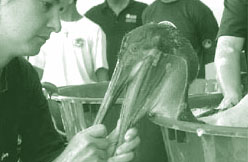Spilling disaster
 at least nine animals died and many sea lions, giant tortoises, colourful blue-footed boobie birds and other pelicans were affected due to an oilspill near Galapagos, an archipelago straddling the equator 1,000 km west of Ecuador.
at least nine animals died and many sea lions, giant tortoises, colourful blue-footed boobie birds and other pelicans were affected due to an oilspill near Galapagos, an archipelago straddling the equator 1,000 km west of Ecuador.
The accident happened when a vessel, Jessica, ran aground after hitting rocks on January 16, 2001, on an embankment near Galapagos' capital and principal port, Puerto Baquerizo Moreno, on San Cristobal Island. The spill started on January 19, 2001 when a pipe burst in the machine room of the boat, leaking a large part of its 908,496 litres fuel cargo into the pristine waters.
"The animals that died are all marine birds, with the exception of a stingray,' said Eliecer Cruz, director of the Galapagos National Park. Environmentalists around the world had feared mass death of birds and sea lions. Fortunately, strong currents carried most of the fuel into the ocean averting an environmental disaster.
But some environmentalists fear long-term environmental damage to the islands. One far-reaching threat, they fear, is that a sunken fuel could have destroyed algae, vital to the foodchain. This could threaten marine iguanas, sharks, birds that feed off fish and other species.
"The worst has already passed. Effects will be felt locally, but it is not going to destroy any species,' said Gunther Reck, an ecology professor at Ecuador's San Francisco University. "The water of Galapagos are washed by a major current system, so contaminated water is not a big issue,' said Mary Wilcox Silver, ocean scientist at the University of California at Santa Cruz.
"The Pacific Ocean waves would erode Jessica out of view within two years,' said Ed Stanton, a coast guard from Ecuador. As the oil and chemical dispersants have nearly all been washed out to sea
Related Content
- Order of the National Green Tribunal regarding capsizing of a barge resulting in spilling of flyash in Sundarbans, South 24 Parganas, West Bengal, 13/03/2023
- Action taken report submitted by the Additional Chief Secretary, Environment, Kerala on oil spillage from Travancore Titanium Products Limited, Kerala, 16/02/2022
- Report on methane gas leak in sugar factory, Solapur, Maharashtra, 28/07/2021
- OIL India report on blowout at well No. 5 in OIL India's Baghjan field, Assam, 27/07/2020
- Preliminary report on oil well blowout and explosion at an OIL well in Baghjan, Tinsukia, Assam, 24/07/2020
- Heavy rains, landslides kill five in Sri Lanka
